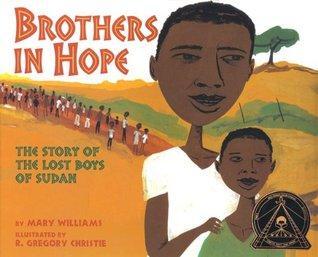
Brothers in Hope
Read Aloud Book: Brothers in Hope
Story: Mary Williams
Illustration: R. Gregory Christie
ISBN-13: 978-1584302322
C3 Framework Key term: Triggering event: An event, sometimes unexpected, that has an immediate consequence, causing another event or process.
Synopsis
When the war reached young Garang’s village in Sudan, he was separated from his family and village community. Together, with thousands of other Lost Boys, he embarks on an arduous journey to Ethiopia to find safety. He assumes the responsibility of a leader in a group of 35 children and takes care of five-year-old Chuti, who is too weak and afraid to endure the journey. In Ethiopia, they find temporary shelter at a refugee camp. The children attend school and pray for the safety of others. The war in Ethiopia sends the boys on another long journey – to Kakuma refugee camp in Kenya. A refugee worker named Tom listens to Garang’s story and works to get international help. As he grows older, Garang tries to improve the conditions in the camp. He helps form a drama club and a soccer team and becomes a health educator. After several years, Tom helps Garang and many other boys immigrate to the United States.
Discussion
Contextualize: Sudan is the largest country on the continent of Africa. The climate of Sudan is tropical towards the Equator in the South and arid in the northern desert. The country suffers period droughts, and people often do not have sufficient access to water. The civil war in Sudan (1983—2005) was between the government and the Sudanese People's Liberation Army, who wanted autonomy of governance in Southern Sudan, control of natural resources, such as oil, and freedom of religion. The Republic of South Sudan gained its independence in 2011. Show the map of the route taken by the Lost Boys to Kenya and Ethiopia and photos depicting the geography of Sudan, Ethiopia, and Kenya. Ask: What did you notice when you looked at the map and the photos? How did the map help you understand the dangers that the boys faced?
Ethics Connection
Distribute a copy of USAID’s map of humanitarian assistance to South Sudan. Ask students to review the program key and color-coded estimated food security levels, on the left side of the map. Say: to address hunger, USAID, through partnering organizations, distributed emergency food assistance to households, treated malnourished young children in outpatient clinics and provided agricultural counseling. In groups, you will prepare a presentation about your group’s answer to one of two questions. Question 1 is: What is the moral obligation of countries to provide humanitarian aid to reduce world hunger? You may address this question through virtues of compassion and caring and countries’ interest such as preventing war and conflict. Question 2 is: How can organizations ensure that aid workers distribute resources in an impartial, fair, and professionally competent manner? You may propose strategies such as, training and supervision, and aid that includes both the goods and the means to protect it.
Fun Activity
Say: Imagine you have accepted a job at the CIA and need to prepare a debrief using the “World Factbook.” Access information about South Sudan. Prepare an “information card” on one page (front and back). The card should include at least four of the following topics: geography, people and society, government, economy, energy, communications, transportation, military and security, and transnational issues.